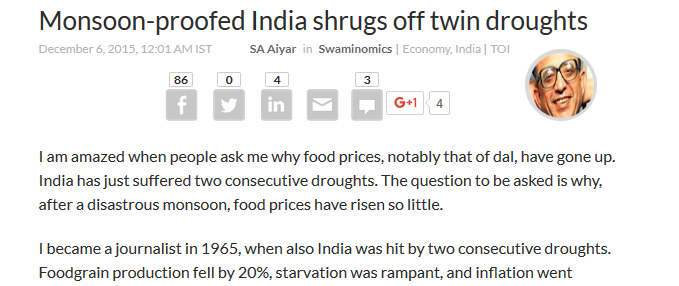I am amazed when people ask me why food prices, notably that of dal, have gone up. India has just suffered two consecutive droughts. The question to be asked is why, after a disastrous monsoon, food prices have risen so little.
I became a journalist in 1965, when also India was hit by two consecutive droughts. Foodgrain production fell by 20%, starvation was rampant, and inflation went through the roof. India was pathetically, humiliatingly dependent for survival on US food aid, and lived a “ship to mouth” existence.
Fifty years later, two back-to-back droughts years have made so little impression on the lives and minds of people that they wonder why food prices are up. GDP data shows that agricultural production actually went up marginally in 2014-15 despite a drought. In the current financial year, agricultural GDP rose by 1.8% in the first quarter and by 2.2% in the second quarter, although the rainfall deficiency was 14.3 % this year against 12% last year. TV cameramen have scoured the worst-hit districts for starving villagers but cannot easily locate any. The drought is simply not a big news story.
A bad monsoon does not just hit agricultural production and prices: it hits industry and services too. Historically, many industries — notably textiles, jute, sugar and edible oils — were dependent on farm output for raw materials. Most jobs were created in sowing, weeding, harvesting, transporting and processing produce. This explains why economist Arvind Virmani once showed that in the first 50 years after independence, no less than 45% of changes in Indian GDP could be explained by changes in rainfall: other factors put together accounted for only 55%.
The twin droughts of 1965 and 1966 led some foreign exerts to opine that India could never feed itself. Famine 1975, a bestselling book by William and Paul Paddock, predicted global famine by 1975. The authors said limited food surpluses of the West should be conserved for countries capable of being saved, while countries incapable of being saved, like India, should be left to starve, for the greater good of humanity. Indians were angered and horrified by the book, yet it was widely applauded in the West. Environmentalist Paul Ehrlich, author of The Population Bomb, praised the Paddock brothers sky-high for having the guts to highlight a Malthusian challenge.
Today, we seem barely aware of two successive droughts. What accounts for the change? Some think the Green Revolution increased food grain availability per head. No, grain availability peaked in 1964 and then declined. Mass starvation ended in subsequent droughts mainly because of better distribution: rural employment programmes provided just enough purchasing power in affected districts. People were still hungry, but did not starve.
Incomes rose over the years and Indians switched from cereals to superior foods. So, per capita consumption of cereals declined. This unexpectedly created grain surpluses. So, in the 1990s India became a substantial net food exporter, and the second largest rice exporter in the world. It continues to export food even in drought years. That is amazing for a country that used to be the greatest beggar for food aid.
The Green Revolution raised yields, enabling more to be produced from the same area. Tubewell irrigation meant the rabi crop increased from one-third the size of the kharif crop to as much or more. The total irrigated area increased from one third to 60%. Drought proofing was substantial.
More important, agriculture’s share in the economy fell steadily, from 52% in 1950 to just 14% today. Services now constitute 60% of the economy, and don’t depend on the monsoon. Industrial production has diversified into engineering and chemical products, and is no longer dominated by farm-based industries like cotton textiles, sugar, and jute textiles.
As incomes rose in the 1970s, farming patterns changed. Per capita production of foodgrains declined, but that of superior foods (like dairy products, edible oil, sugar, tea, eggs, fruit and vegetables) went up. These superior foods provided farmers with more income even as they satisfied the changing needs of a society getting better off.
The share of traditional crops — including cash crops like oilseeds, fibres and sugarcane — dropped from two-thirds to just half of total production. The other half consists mainly of fruits and vegetables, poultry, fisheries, and livestock. These activities are much less monsoon-dependent than traditional crops, and help explain why agricultural GDP managed to rise 2.2% in July-September this year despite a drought.
However, this success has been accompanied by grave environmental damage. Free electricity to farmers has encouraged over-pumping and alarming aquifer depletion. Politicians refuse to charge farmers for power, saying this will lose them elections. One compromise may be to give a free solar pump to every farmer, and charge for other electric supplies.


